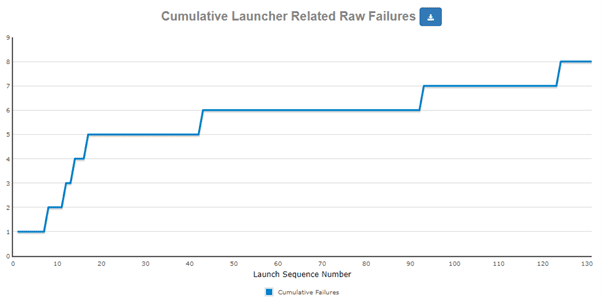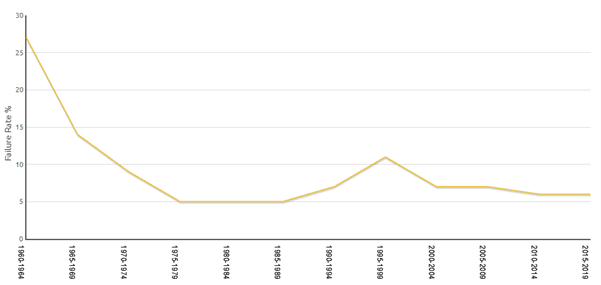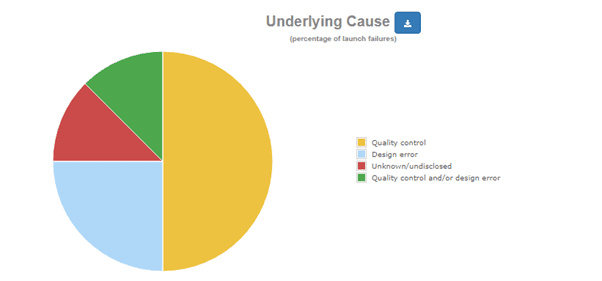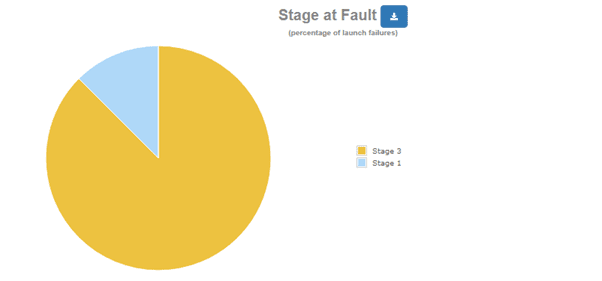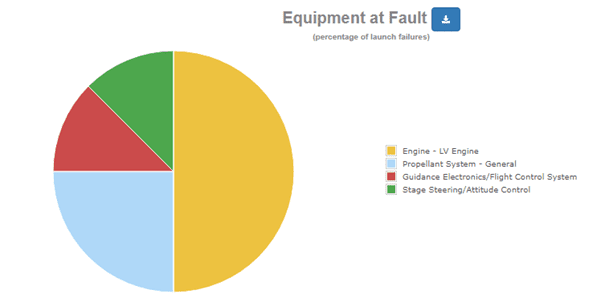Seradata produces the Seradata database (formerly SpaceTrak) which covers ALL Orbital launch attempts since the first orbital launch: Sputnik in 1957. The Seradata is used by most of the world’s Space insurance underwriters and brokers for launch and spacecraft reliability information, historical Space insurance claims and loss values.
For over forty years, Seradata (and its predecessors) have been collating data on orbital rocket launches and spacecraft histories. We believe we have a complete data set of orbital launches and of suborbital launches related to orbital systems (plus Space industry related suborbital) along with the spacecraft carried.
The launch phase outcome – success or failure – is judged and recorded at individual spacecraft level. From this, a raw failure rate, for the launch vehicle and satellite bus design can been calculated. By a further assessment of the effect on each spacecraft mission, a modified failure rate is also deduced.
For spacecraft, launch phase means from the ground to final position; failures are categorized as pre-or post-separation and the cause is assigned either to the launch vehicle or to the spacecraft (satellite). Those failures which cause insurance losses are also specially noted, along with their loss value in US$ and as a percentage of the insured value at the time of loss.
In addition, Seradata also tracks satellite in-orbit anomalies and satellite insurance claims post this launch phase, see our satellite reliability page.
Launch vehicles have the mission to safely deliver their spacecraft payloads at their specified orbit. This may be the orbit they intend to operate from, or into a transfer orbit, or into an interim orbit from where the spacecraft will raise itself/themselves to their required operational orbit.
If any spacecraft payload on a given launch is mis-injected, damaged or destroyed by the vehicle the launch is designated a ‘raw’ failure. If the spacecraft can function and even be recovered to its eventual operational orbit, the capability lost may not be 100 per cent. Likewise, it may be the case when some spacecraft injected correctly, others not. As such, an adjusted launch failure rate can be calculated sometimes making the launch failure a “partial failure”.
To take account of the relative “importance” of a spacecraft on a launch, we also offer a ‘Mass Adjusted failure rate’ which takes into account a spacecraft’s relative proportion of total launched payload mass on a given launch.
The Seradata database offers several levels of satellite insurance data and results. For example, a space insurance data analyst wanting to build up a risk picture for each element involved in an imminent launch, may opt to run Seradata standard reports, focusing on the past reliability of the Launch Vehicle, the Satellite Bus (or their families) and the Spacecraft operator/owner concerned.
For launch vehicle analysis, Seradata launch vehicle data is provided at four levels: Family, Type, Variant and Minor Variant. This enables the user to specify the desired population they wish to analyse.
For those wanting to extract space insurance data for a more bespoke detailed analysis, the Seradata Query Tool enables more complex filters and comparisons to be built, viewed, and exported to an Excel spreadsheet in seconds.
The query system also allows for analysis by time which may be measured in days/years since launch, or via flight/launch sequence number.
To calculate the failure rate it is necessary to compare the failures to the attempts. To assist with this common use case, the Seradata Query Tool facilitates Comparison queries.
As an example, the chart below shows the launch failures for the Vehicle Type = LONG MARCH 3 SERIES. In this case, at the time of writing, the Long March 3 had made 131 orbital attempts with eight failures, a raw rate of 6.1 per cent. However, by making the above-mentioned adjustments for actual mission loss and spacecraft recovery the adjusted failure rate improves to 4.6 per cent.
However, that is not the whole story. As you can see the Long March 3 Series reliability improves with time.
Long March 3 Series, Launch Failures. Source: Seradata database
As is typical for most modern launch vehicles, the Long March 3 exhibits a high failure rate in the early programme. After twenty flights, or so, reliability settles down and failures become less frequent.
In this case the raw failure rate for the last fifty attempts is actually, two raw failures out of 50 which is 4 per cent – a significantly better result that the 6.1 per cent raw failure rate overall.
As design and manufacturing technology improves and as the number of flights increases (increasing the maturity of a system) it is reasonable to expect that reliability would improve. This is the case in most US and European launch vehicles such as Ariane 5 and Falcon 9 which can approach a “Nirvana” status of having a near “zero” recent failure rate. This does not mean that random failures may not occur, but it does mean that they are rare.
When looking at all launch history, the improvement over time in launch vehicle reliability appears to have ended since the steep improvement in the 1960s and 1970s. The launch failure rate appears to have become stuck at around six per cent. This, and especially the hump in the 1990s, may be due to the introduction of serval new vehicles with their high early flight failures pushing the overall rate up.
Long-run, Launch Failures Rate, all orbital attempts. Source: Seradata database
Seradata has added new fields to deepen the analysis of launch failures. A key categorization we have added is the Underlying Cause, which gives an indication of what might be going wrong. Returning to our Long March 3 series example, we can see that half of the failures have been attributed to ‘Quality Control’ i.e. manufacturing issues.
Long March 3 Series, Launch Failures by Underlying Cause. Source: Seradata database
In the recent months, Seradata been applying subsystem data to all the launch vehicles in the database, focussed on stages and engines. In the case of the eight Long March 3 failures, seven were stage three related.
Long March 3 Series, Launch Failures by Stage. Source: Seradata database
A further analysis identifies the Equipment at Fault. The chart below reveals that half the eight failures were engine related.
Long March 3 Series, Launch Failures by Equipment at Fault. Source: Seradata database
For more information about satellite insurance data or the Seradata database and how to subscribe, go to seradata.com/product. If you wish to arrange an online demonstration, please contact us by email: info@seradata.com.

